QR Codes Market Size
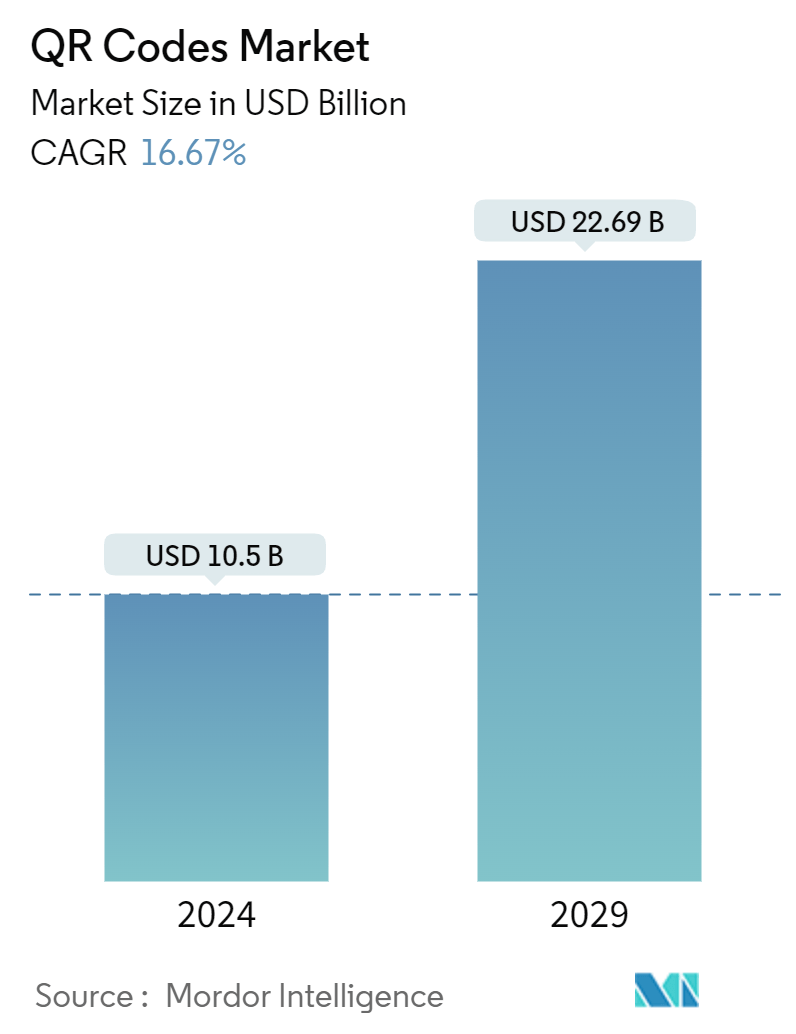
| Study Period | 2019 - 2029 |
| Market Size (2024) | USD 10.5 Billion |
| Market Size (2029) | USD 22.69 Billion |
| CAGR (2024 - 2029) | 16.67 % |
| Fastest Growing Market | Asia Pacific |
| Largest Market | North America |
Major Players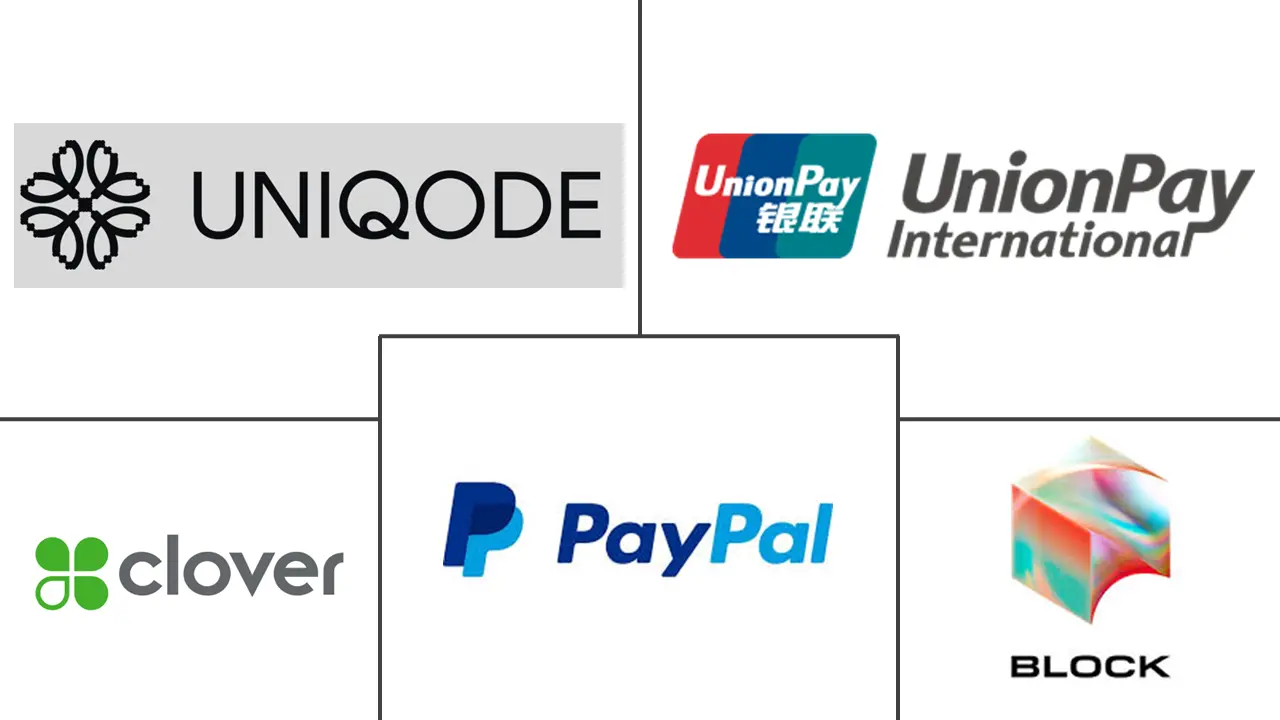
*Disclaimer: Major Players sorted in no particular order |
QR Codes Market Analysis
The QR Codes Market size is estimated at USD 10.5 billion in 2024, and is expected to reach USD 22.69 billion by 2029, growing at a CAGR of 16.67% during the forecast period (2024-2029).
- • A Quick Response code (QR code) is a 2D barcode that can be scanned by digital devices like smartphones to access information quickly. Unlike traditional barcodes, which are one-dimensional and can be read in one direction only, QR codes can be scanned in two dimensions, both top to bottom and right to left, allowing them to store significantly more information.
- • QR codes serve diverse purposes, ranging from sharing basic business card information to facilitating sophisticated functions like touchless payments, WiFilogins, event check-ins, and online ordering. This adaptability caters to a multitude of business requirements.
- • The proliferation of smartphones globally is anticipated to be a primary driver for the growth of the QR code market. The accessibility of high-quality cameras and internet connectivity on mobile devices has made scanning QR codes effortless for consumers. As more people acquire smartphones, the user base for QR codes expands, leading to increased adoption across various sectors, including hospitality, retail, and healthcare.
- • For instance, according to Ofcom, the smartphone penetration rate in the United Kingdom increased each year since 2016, reaching an overall figure of 94% in 2023. Those aged between 24 and 34 and 35 and 54 years recorded the highest smartphone penetration rate. Despite increasing saturation in developed regions, there is still room for growth in many large, underpenetrated markets in developing regions. For instance, according to GSMA, India and Sub-Saharan Africa will account for nearly half of new mobile subscribers globally over the 2022–2030 period.
- • According to Ericsson, the number of smartphone mobile network subscriptions worldwide reached around 7 billion in 2023 and is estimated to exceed 7.7 billion by 2028. The United States, India, and China are among the countries with the highest number of smartphone mobile network subscriptions.
- • E-commerce platforms and mobile shopping apps are swiftly adopting QR code payments. During online purchases, customers now have the option to select QR code payments at checkout. After confirming their purchase, users can seamlessly and securely complete the transaction by scanning the generated QR code using either a mobile banking app or a dedicated QR code payment app. This technology streamlines the payment process and enhances the overall convenience of online shopping. Furthermore, numerous companies have integrated QR code payments with loyalty programs to boost consumer engagement and retention.
- • QR codes significantly enhance marketing campaigns by simplifying decision-making for consumers. They provide seamless access to sign-up pages, websites, and landing pages, thereby boosting engagement with targeted audiences across multiple platforms. Furthermore, businesses can track who scans their materials, how frequently, the devices used, and the timing of each scan through QR codes. Such tracking offers businesses crucial insights into customer engagement, repeat clientele, and general feedback.
- • However, QR code-based government payments, often tied to legislation, vary significantly across jurisdictions. These regulatory challenges encompass taxation and other complexities. In certain cases, stringent regulations hinder companies and start-ups from providing QR code payment services. The intricate regulatory landscape can deter potential market entrants due to the time investment required. Moreover, the regular collection and processing of financial and personal data during QR code transactions amplifies users' privacy concerns.
- • Furthermore, in low and middle-income countries, the general public lacks access to sophisticated smartphones, rendering QR codes unusable. This is because smartphones capable of scanning QR codes come at a premium, outpacing the cost of basic mobile phones. Several factors, such as limited comprehension of the technology, the inconvenience of scanning, and security concerns regarding payments and QR code scanning, may hinder the widespread adoption of QR codes.
QR Codes Market Trends
The Payments and Transactions Segment is Anticipated to Witness a Significant Growth
- • QR code scanner apps facilitate contactless transactions, allowing quick and secure payments without any physical touch. This approach bolsters security by ensuring sensitive payment details remain in the digital domain.
- • QR codes have revolutionized payment processes, enabling consumers to transact effortlessly. The adoption of QR code-based mobile payments in India has been significantly high. Many mobile users now rely on apps such as Google Pay, Paytm, and PhonePe for their transactions. Given the current trajectory, the QR code-based mobile payment ecosystem is poised for continued growth, ensuring users enjoy a secure, convenient, and efficient means of managing their financial transactions.
- • To that extent, in April 2024, Fintech company Cred launched a UPI-based 'Scan and Pay' service that enables members to use any QR code to make payments from the consumer's bank accounts. The launch marks Cred's foray into the offline payments space dominated by PhonePe, Google Pay, and Paytm. The company claimed that it would be convenient to make offline payments at large format stores comprising supermarkets, fast-food joints, beauty salons, fashion boutiques, and various lifestyle retailers. Such innovations are likely to aid the growth of the market.
- • Furthermore, according to Payments Japan, in 2023, the total value of QR code and barcode payments made at physical and online stores in Japan amounted to around JPY 14.9 trillion (~USD 103.53 billion). QR code payment services emerged as the second-most popular payment method, surpassing electronic money for the second consecutive time that year. Hence, such trends support the market's growth.
- • In April 2024, Infcurion, a developer of a BaaS platform designed to promote financial digitalization, new businesses, and a digital Index, conducted a survey. Around 68% of respondents in Japan reported using QR code payment apps. The number of monthly active QR code payment service users has gradually increased in recent years. Approximately 51% of respondents in Japan used the QR code payment service PayPay. The second most common service was Rakuten Pay, with 23% of respondents stating they used the payment app.
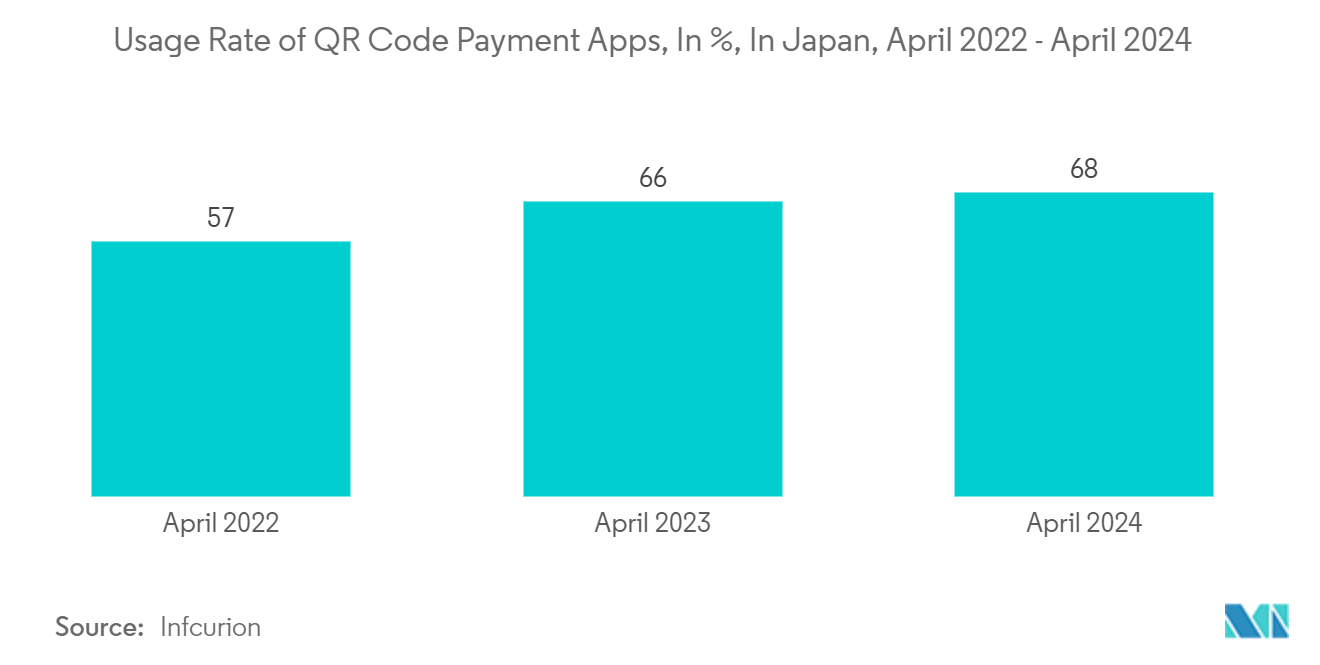
North America is Anticipate to Hold a Significant Market Share
- • Efficient advertising significantly drives the need for QR codes in North America. QR codes elevate user engagement beyond conventional advertising methods. By scanning these codes, users can seamlessly access social media pages, online stores, or contest links, fostering a deeper connection with the brand.
- • The growing demand for sustainable solutions is also driving the development of the North American market. By digitizing user manuals and catalogs via QR codes, businesses can reduce paper usage, save on printing costs, and promote eco-friendly practices. Furthermore, by updating the content of QR codes, companies can avoid the hassle of frequent reprints.
- • As businesses increasingly depend on digital transactions, security has become paramount in North America. QR codes can incorporate encryption and authentication methods, enhancing transaction security and data sharing. Companies use QR codes to authenticate products and prevent counterfeiting, particularly in industries like pharmaceuticals and luxury goods, requiring stringent security measures. This focus on security drives demand for QR codes as a reliable solution.
- • Another factor driving market adoption is the degree to which a QR code supports participation and interoperability across payment types for banks and non-banks and addresses a country’s needs and preferences. Most proprietary QR codes are specific to the payment network for which they were created. This requires the scanning device or app to support scanning QR codes from multiple payment schemes unless the device has separate apps specific to using each proprietary QR code payment scheme. This may be simple for the payment network but can become a friction point for some end users who may have to use multiple apps.
- • To that extent, in August 2024, the Accredited Standards Committee X9 Inc. announced that it would develop a new QR code payments standard. The new standard will establish the content of a QR code for payments, emphasizing interoperability to process a payment digitally. It will include both merchant-presented and customer-presented QR Codes. Encoded in a payment QR code will be all the information necessary to execute a payment without the customer or merchant having to share financial account details.
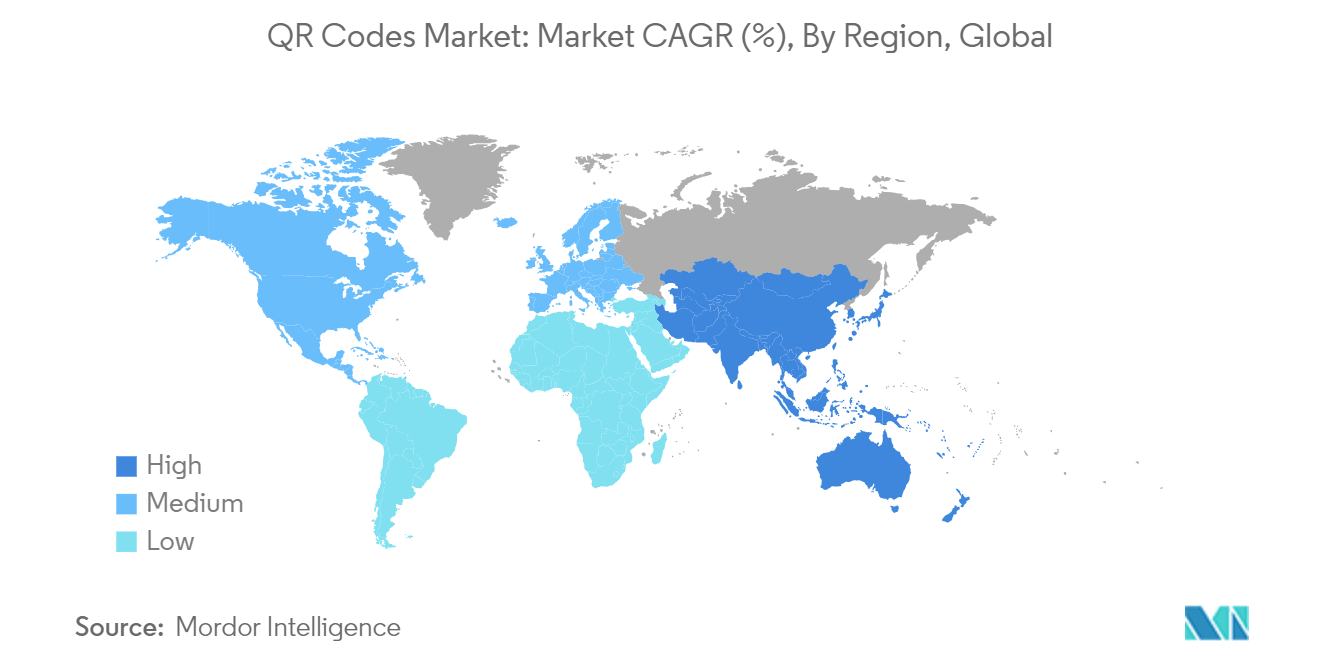
QR Codes Industry Overview
The QR Codes Market is fragmented, with several major players, such as Uniqode Phygital Inc., PayPal Inc., UnionPay International Co. Ltd, and Clover Network LLC, among others. These market players strive to innovate new products through extensive investments in R&D, collaborations, and mergers to cater to consumers' evolving demands.
• July 2024 - The Open Network for Digital Commerce (ONDC) introduced an interoperable QR code to empower a diverse range of sellers, from local artisans to neighborhood shopkeepers. As per the company's announcement, these interoperable QR codes are presently in their alpha phase. They enable sellers to create a unique QR code. Customers can scan this code using any ONDC-registered buyer app, beginning with Magician and Paytm. The feature is set to expand across the entire network following initial testing.
• July 2024 - The National Payments Corporation of India expanded its UPI payments service to the United Arab Emirates. Indian travelers or NRIs in the UAE will be able to make payments using UPI through a QR code at Point-of-Sale machines.
QR Codes Market Leaders
-
Uniqode Phygital, Inc.
-
UnionPay International Co., Ltd.
-
Block, Inc. (Square)
-
Clover Network, LLC
-
PayPal, Inc.
*Disclaimer: Major Players sorted in no particular order
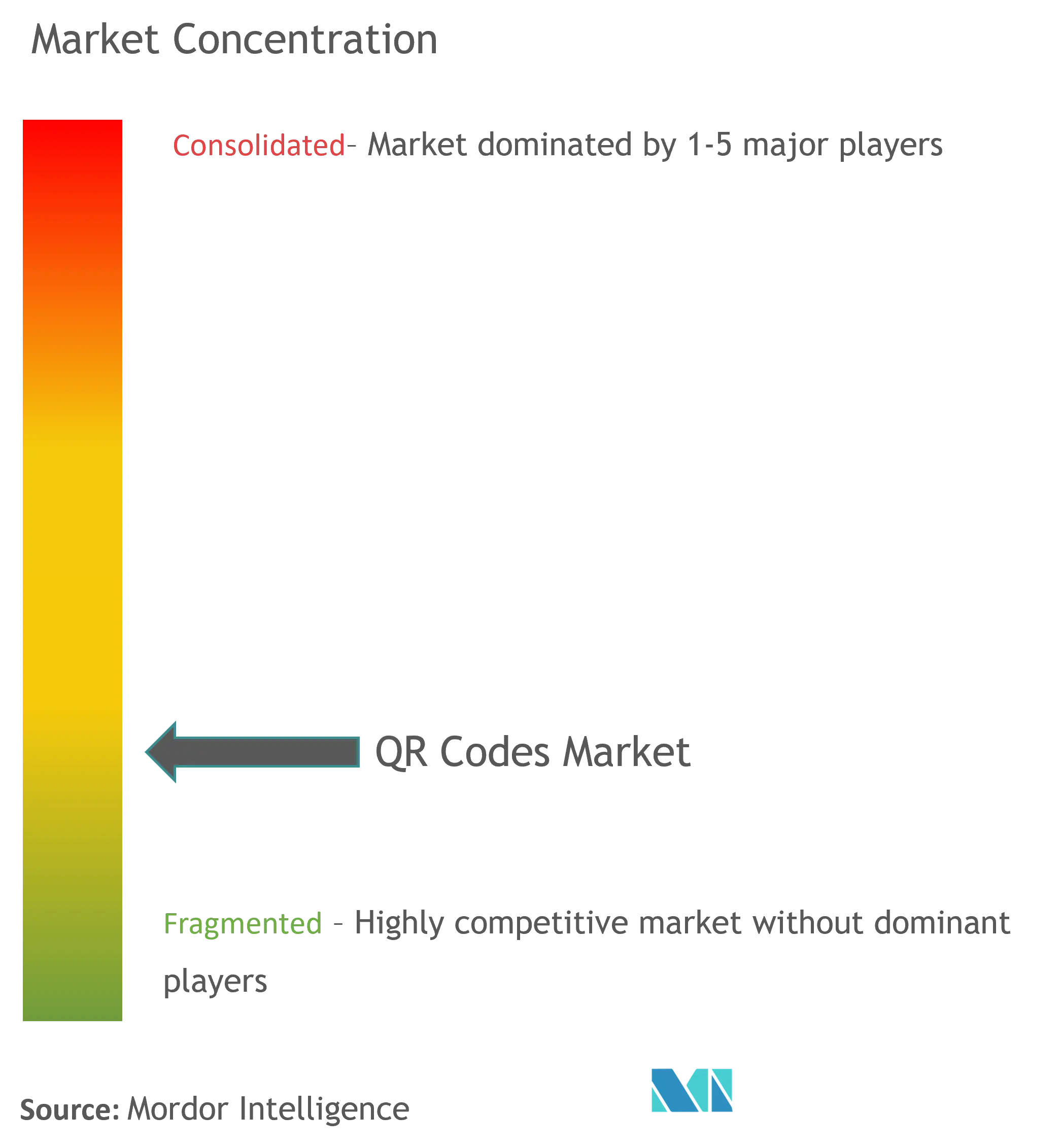
QR Codes Market News
- July 2024: Bandhan Bank launched its latest payment solution through the Bharat QR Code for its Current account and Savings account customers. The bank claimed that the solution will simplify how these self-employed segment customers make payments at any merchant outlet. An instant notification will also be received on every payment through a small speaker.
- June 2024: Flowcode, a marketing technology platform, unveiled a reimagined product designed for marketing and analytics teams at F1000 companies focused on measuring and maximizing offline conversions. Flowcode integrates seamlessly with data feeds, such as product catalogs, MLS listings, and more, to automate the creation of personalized, QR-enabled user journeys. This empowers brands to deliver unique, tailored consumer experiences, significantly increasing conversion rates.
QR Codes Market Report - Table of Contents
1. INTRODUCTION
- 1.1 Study Assumptions and Market Definition
- 1.2 Scope of the Study
2. RESEARCH METHODOLOGY
3. EXECUTIVE SUMMARY
4. MARKET INSIGHTS
- 4.1 Market Overview
-
4.2 Industry Attractiveness - Porter's Five Forces Analysis
- 4.2.1 Bargaining Power of Suppliers
- 4.2.2 Bargaining Power of Buyers
- 4.2.3 Threat of New Entrants
- 4.2.4 Threat of Substitute Products
- 4.2.5 Intensity of Competitive Rivalry
- 4.3 Industry Value Chain Analysis
- 4.4 Impact of COVID-19 Aftereffects and Other Macroeconomic Factors on the Market
5. MARKET DYNAMICS
-
5.1 Market Drivers
- 5.1.1 Increased Smartphone Penetration
- 5.1.2 Growing Demand for Contactless Solutions
- 5.1.3 Increasing need for Security and Fraud Prevention
-
5.2 Market Restraint
- 5.2.1 Regulatory Challenges and Privacy Concerns
6. MARKET SEGMENTATION
-
6.1 By Type
- 6.1.1 Website QR Code
- 6.1.2 Menu QR Code
- 6.1.3 File Download QR Code
- 6.1.4 Social Media QR Code
- 6.1.5 App Store
- 6.1.6 Others
-
6.2 By Format
- 6.2.1 Static QR Code
- 6.2.2 Dynamic QR Code
-
6.3 By End-User Application
- 6.3.1 Marketing and advertising
- 6.3.2 Payments and Transactions
- 6.3.3 Information Sharing
- 6.3.4 Customer engagement
- 6.3.5 Others
-
6.4 By Geography***
- 6.4.1 North America
- 6.4.2 Europe
- 6.4.3 Asia
- 6.4.4 Australia and New Zealand
- 6.4.5 Latin America
- 6.4.6 Middle East and Africa
7. COMPETITIVE LANDSCAPE
-
7.1 Company Profiles
- 7.1.1 Uniqode Phygital, Inc.
- 7.1.2 QR TIGER PTE. LTD.
- 7.1.3 Flowcode
- 7.1.4 PayPal, Inc.
- 7.1.5 Storepay Inc.
- 7.1.6 UnionPay International Co., Ltd.
- 7.1.7 Block, Inc. (Square)
- 7.1.8 Nearex Technologies Pvt. Ltd.
- 7.1.9 LINE Pay Corporation
- 7.1.10 Revolut Technologies Inc.
- 7.1.11 Ecentric Payment Systems
- 7.1.12 Clover Network, LLC
- *List Not Exhaustive
8. INVESTMENT ANALYSIS
9. FUTURE OF THE MARKET
** Subject To AvailablityQR Codes Industry Segmentation
A QR code, a form of barcode, can be effortlessly scanned by digital devices, encoding information as a matrix of pixels within a square grid. Commonly, QR codes serve to monitor product details within a supply chain. Moreover, with the widespread integration of QR readers in smartphones, they have become a staple in marketing and advertising initiatives.
The revenue generated from various QR code solutions sales in a diverse range of geographic regions worldwide is tracked for market estimation. Many companies in the QR code market utilize a transaction-based revenue model, earning revenue from each transaction processed through their QR code systems. This is particularly common in payment solutions, where businesses charge a fee for each payment via QR codes. Some QR code service providers offer subscription-based services, where businesses pay a recurring fee to access premium features, analytics, or enhanced functionalities. Companies can also generate revenue by analyzing the data collected through QR code interactions. Other types of revenue models in the market include freemiums, custom solutions and customizations, partnerships and collaborations, and advertising and marketing revenue.
The QR codes market is segmented by QR code type (website QR code, menu QR code, file download QR code, social media QR code, app store QR code, and others), by format (static QR code and dynamic QR code), by end-user application (marketing and advertising, payments and transactions, information sharing, customer engagement, and others), and by geography (North America, Asia-Pacific, Europe, Latin America, Middle East and Africa). The market sizes and forecasts are provided in terms of value (USD) for all the above segments.
| By Type | Website QR Code |
| Menu QR Code | |
| File Download QR Code | |
| Social Media QR Code | |
| App Store | |
| Others | |
| By Format | Static QR Code |
| Dynamic QR Code | |
| By End-User Application | Marketing and advertising |
| Payments and Transactions | |
| Information Sharing | |
| Customer engagement | |
| Others | |
| By Geography*** | North America |
| Europe | |
| Asia | |
| Australia and New Zealand | |
| Latin America | |
| Middle East and Africa |
QR Codes Market Research FAQs
How big is the QR Codes Market?
The QR Codes Market size is expected to reach USD 10.5 billion in 2024 and grow at a CAGR of 16.67% to reach USD 22.69 billion by 2029.
What is the current QR Codes Market size?
In 2024, the QR Codes Market size is expected to reach USD 10.5 billion.
Who are the key players in QR Codes Market?
Uniqode Phygital, Inc., UnionPay International Co., Ltd., Block, Inc. (Square), Clover Network, LLC and PayPal, Inc. are the major companies operating in the QR Codes Market.
Which is the fastest growing region in QR Codes Market?
Asia Pacific is estimated to grow at the highest CAGR over the forecast period (2024-2029).
Which region has the biggest share in QR Codes Market?
In 2024, the North America accounts for the largest market share in QR Codes Market.
What years does this QR Codes Market cover, and what was the market size in 2023?
In 2023, the QR Codes Market size was estimated at USD 8.75 billion. The report covers the QR Codes Market historical market size for years: 2019, 2020, 2021, 2022 and 2023. The report also forecasts the QR Codes Market size for years: 2024, 2025, 2026, 2027, 2028 and 2029.
QR Codes Industry Report
Statistics for the 2024 QR Codes market share, size and revenue growth rate, created by Mordor Intelligence™ Industry Reports. QR Codes analysis includes a market forecast outlook for 2024 to 2029 and historical overview. Get a sample of this industry analysis as a free report PDF download.



